What If? (24 page)
Authors: Randall Munroe

Yoda
Q.
How much Force power can Yoda output?
—Ryan Finnie
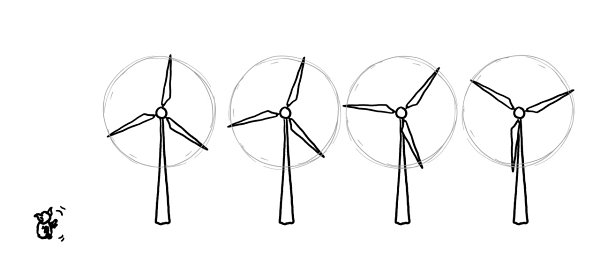
A.
I’m going to—
of course—ignore the prequels.
Yoda’s greatest display of raw power in the original trilogy came when he lifted Luke’s X-wing from the swamp. As far as physically moving objects around goes, this was easily the biggest expenditure of energy through the Force we saw from anyone in the trilogy.
Th
e energy it takes to lift an object to a given height is equal
to the object’s mass times the force of gravity times the height it’s lifted.
Th
e X-wing scene lets us use this to put a lower limit on Yoda’s peak power output.
First we need to know how heavy the ship was.
Th
e X-wing’s mass has never been canonically established, but its length has
—
12.5 meters. An F-
22
is 19 meters long and weighs 19,700 kg, so scaling down from this gives an estimate for
the X-wing of about 12,000 pounds (5 metric tons).
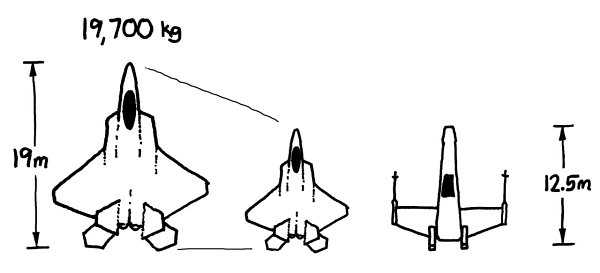

Next, we need to know how fast it was rising. I went over footage of the scene and timed the X-wing’s rate of ascent as it was emerging from the water.

Th
e front landing strut rises out of the water in about three and a half seconds, and I estimated the strut to be 1.4 meters long (based on a scene in
A New Hope
where a crew member squeezes past it), which tells us the X-wing was rising at 0.39 m/s.
Lastly, we need to know the strength of gravity on Dagobah. Here, I figure I’m stuck, because while sci-fi fans are obsessive,
it’s not like there’s gonna be a catalog of minor geophysical characteristics for every planet visited in
Star Wars
. Right?
Nope. I’ve underestimated the fandom. Wookieepeedia has just such a catalog, and informs us that the surface gravity on Dagobah is 0.9g. Combining this with the X-wing mass and lift rate gives us our peak power output:

Th
at’s enough to power a block of suburban homes. It’s also equal to about 25 horsepower, which is about the power of the motor in the electric-model Smart Car.
At current electricity prices, Yoda would be worth about $2/hour.
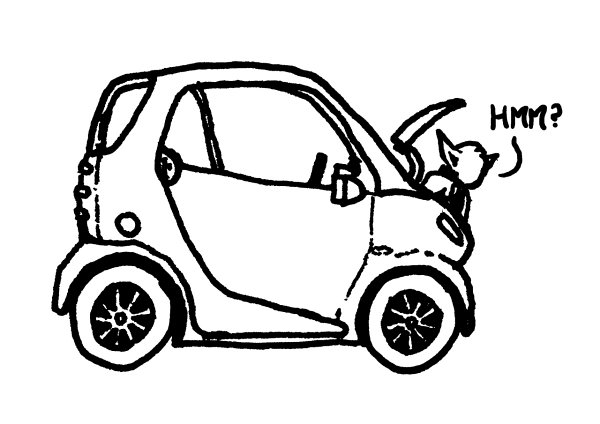
But telekinesis is just one type of Force power. What about that lightning the Emperor used to zap Luke?
Th
e physical nature of it is never made clear, but Tesla coils that produce similar displays draw something like 10 kilowatts
—
which would put the Emperor roughly on par with Yoda. (
Th
ose Tesla coils typically use lots of very short pulses. If the Emperor is sustaining a continuous
arc, as in an arc welder, the power could easily be in the megawatts.)
What about Luke? I examined the scene where he used his nascent Force powers to yank his lightsaber out of the snow.
Th
e numbers are harder to estimate here, but I went through frame-by-frame and came up with an estimate of 400 watts for his peak output.
Th
is is a fraction of Yoda’s 19kW, and was sustained for only a fraction
of a second.
So Yoda sounds like our best bet as an energy source. But with world electricity consumption pushing 2 terawatts, it would take a hundred million Yodas to meet our demands. All things considered, switching to Yoda power probably isn’t worth the trouble
—
though it would
definitely
be green.
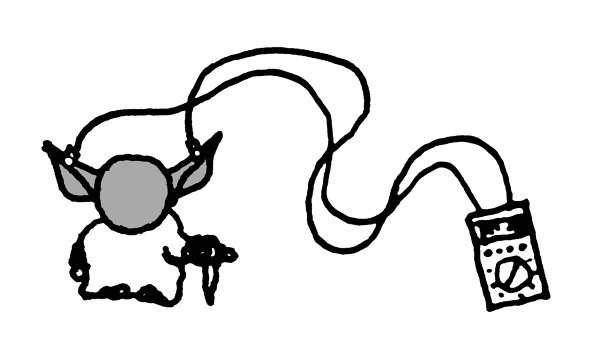
Flyover States
Q.
Which US state is actually flown over the most?
—Jesse Ruderman
A.
When people say “flyover
states,” they’re usually referring to the big, square states out west that people stereotypically cross over while flying between New York, LA, and Chicago, but don’t actually land in.
But what state do the largest number of planes
actually
fly over?
Th
ere are a lot
of flights up and down the East Coast; it would be easy to imagine that people fly over New York more often than Wyoming.
To figure out what the real flyover states are, I looked at over 10,000 air traffic routes, determining which states each flight passed over.
Surprisingly, the state with the most planes flying over it
—
without taking off or landing
—
is . . .

. . .
Virginia.
Th
is result surprised me. I grew up in Virginia, and I certainly never thought of it as a “flyover state.”
It’s surprising because Virginia has several major airports; two of the airports serving DC are actually located in Virginia (DCA/Reagan and IAD/Dulles).
Th
is means most flights to DC don’t count toward flights over Virginia, since those flights
land
in Virginia.
Here’s a map of US states colored by number of daily flyovers:
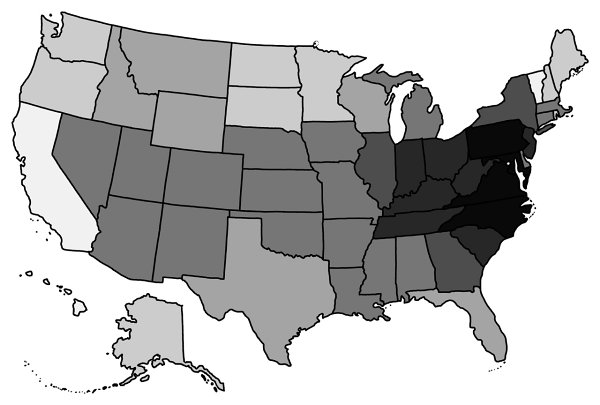
Close behind Virginia are
Maryland,
North Carolina,
and
Pennsylvania.
Th
ese states have substantially more daily flyovers than any other.
So why Virginia?
Th
ere are a number of factors, but one of the biggest is
Hartsfield-Jackson Atlanta International Airport.
Atlanta’s airport is the busiest in the world, with more passengers and flights than Tokyo, London, Beijing,
Chicago, or Los Angeles. It’s the main hub airport for Delta Air Lines
—
until recently the world’s largest airline
—
which means passengers taking Delta flights will often connect through Atlanta.
Th
anks to the large volume of flights from Atlanta to the northeast US, 20 percent of all Atlanta flights cross Virginia and 25 percent cross North Carolina, contributing substantially to the totals
for each state.
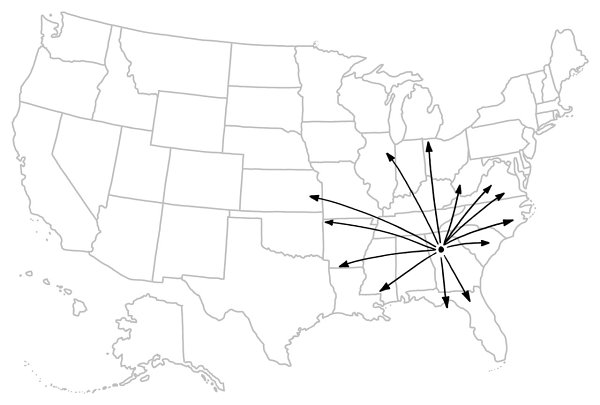
However, Atlanta isn’t the biggest contributor to Virginia’s totals.
Th
e airport with the most flights over Virginia was a surprise to me.
Toronto Pearson International Airport
(
YYZ
) seems an unlikely source of Virginia-crossing flights, but Canada’s largest airport contributes more flights over Virginia than New York’s JFK and LaGuardia airports
combined
.
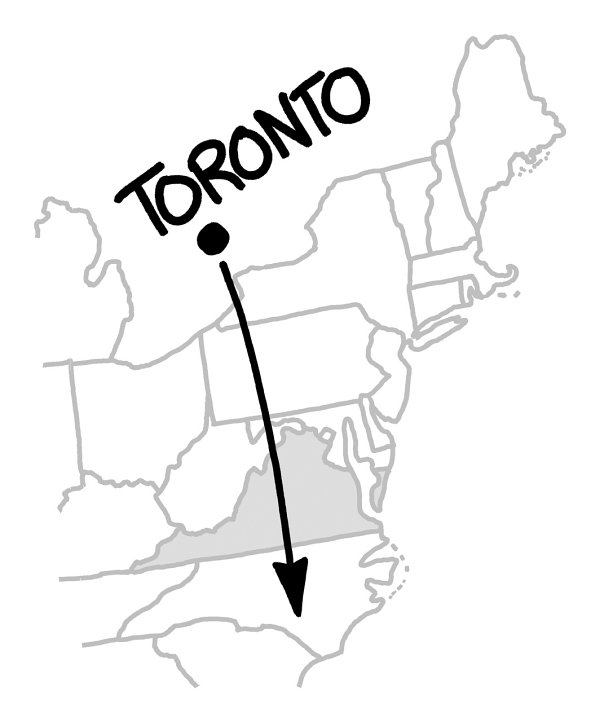
Part of the reason for Toronto’s dominance is that it has many direct flights to the Caribbean and South America, which cross US airspace on the way to their destinations.
1
In addition to Virginia, Toronto is also the chief source of flights over West Virginia, Pennsylvania, and New York.
Th
is map shows, for each state, which airport is the source of the most flights over it:
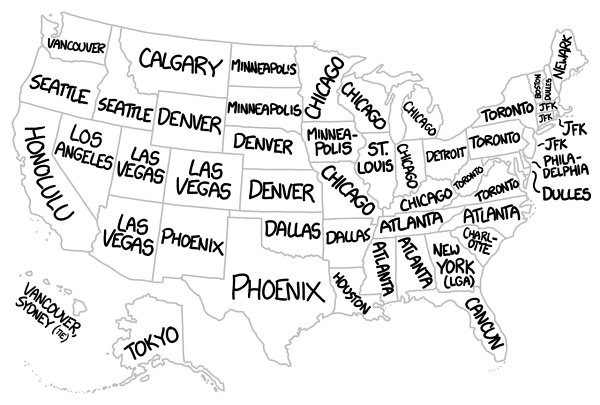
Flyover states by ratio
Another possible definition of “flyover state” is the state that has the highest ratio of flights
over
it to flights
to
it. By this measure, the flyover states are, for the most part, simply the least dense states.
Th
e top ten include, predictably, Wyoming, Alaska, Montana, Idaho, and the Daktoas.
Th
e state with the
highest
ratio of flights-over-to-flights-to,
however, is a surprise:
Delaware.
A little digging turned up the very straightforward reason: Delaware has no airports.
Now, that’s not quite true. Delaware has a number of airfields, including Dover Air Force Base (
DOV
) and New Castle Airport (
ILG
). New Castle Airport is the only one that might qualify as a commercial airport, but after Skybus Airlines shut down in 2008, the airport
had no airlines serving it.
2
Least flown-over state
Th
e least flown-over state is Hawaii, which makes sense. It consists of tiny islands in the middle of the world’s biggest ocean; you have to try pretty hard to hit it.
Of the 49 non-island states,
3
the least flown-over state is California.
Th
is came as a surprise to me, since California is long and skinny, and it seems like a lot
of flights over the Pacific would need to pass over it.
However, since jet-fuel-laden planes were used as weapons on 9/11, the FAA has tried to limit the number of unnecessarily fuel-heavy flights crossing the US, so most international travelers who might otherwise travel over California instead take a connecting flight from one of the airports there.
Fly-under states
Lastly, let’s
answer a slightly stranger question: What is the most flown-
under
state?
Th
at is, what state has the most flights on the opposite side of the Earth pass directly under its territory?
Th
e answer turns out to be
Hawaii.
Th
e reason such a tiny state wins in this category is that most of the US is opposite the Indian Ocean, which has very few commercial flights over it. Hawaii, on the other
hand, is opposite Botswana in Central Africa. Africa doesn’t have a high volume of flights over it compared to most other continents, but it’s enough to win Hawaii the top spot.
Poor Virginia
As someone who grew up there, it’s hard for me to accept Virginia’s status as the most flown-over state. If nothing else, when I’m back home with family, I’ll try to remember
—
once in a while
—
to look
up and wave.
(And if you find yourself on Arik Air Flight 104 from Johannesburg, South Africa to Lagos, Nigeria
—
daily service, departing at 9:35
a.m.
—
remember to look down and say “Aloha!”)
- 1
It helps that Canada, unlike the US, has extensive commercial flight service to Cuba.
- 2
Th
is changed in 2013, when Frontier Airlines began operating
a route between New Castle Airport and Fort Myers, Florida.
Th
is wasn’t included in my data set, and it’s possible Frontier will bump Delaware down the list.
- 3
I’m including Rhode Island here, although it seems wrong to.
